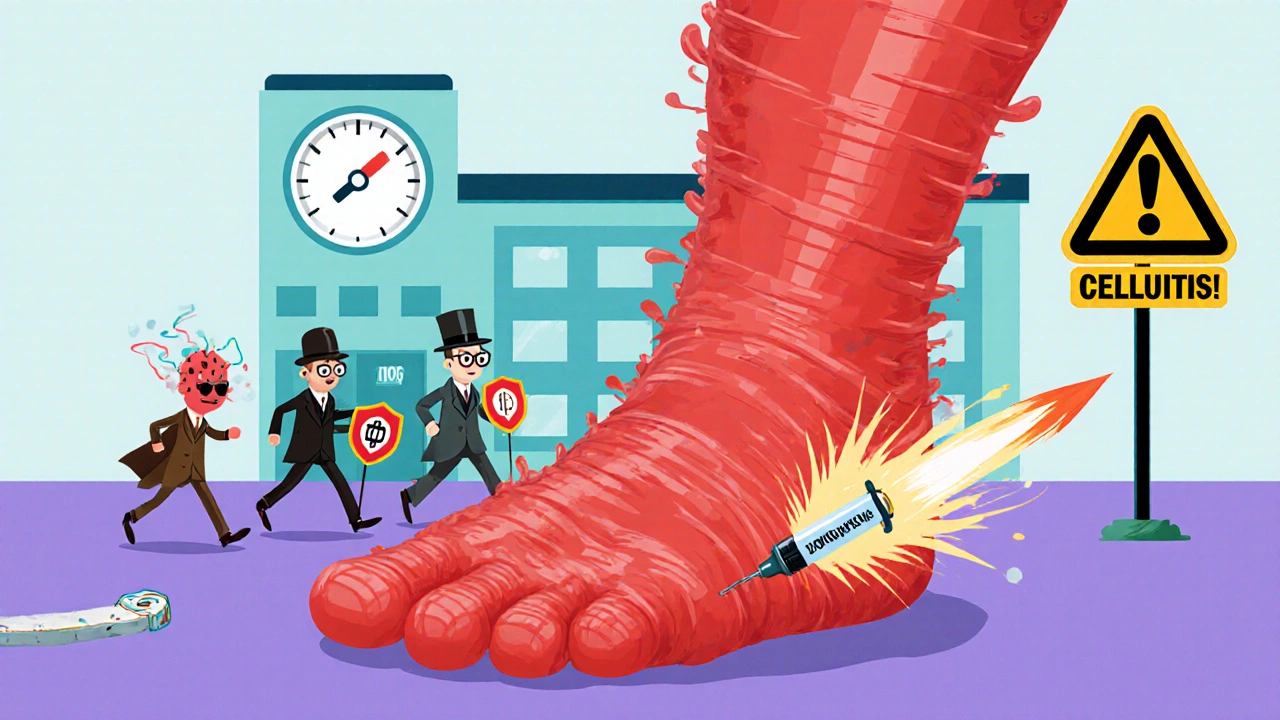
When your child comes home from school with red, crusty sores around the nose, or you wake up with a swollen, hot patch of skin on your leg, it’s easy to assume it’s just a minor rash. But these could be signs of bacterial skin infections - specifically impetigo or cellulitis. These aren’t just annoying rashes. They’re infections that spread fast, need the right antibiotics, and can turn dangerous if ignored.
What Is Impetigo, and Why Is It So Common in Kids?
Impetigo is the most common bacterial skin infection in children under 5. You’ll see it in daycare centers, schools, and playgrounds. It starts as tiny red bumps or blisters that quickly turn into oozing sores. Within a few days, they form a thick, honey-colored crust - which is why doctors call it "school sores."
It’s not just ugly - it’s contagious. One kid with impetigo can spread it to others through shared towels, toys, or even a quick hug. About 70% of cases are the nonbullous type, meaning small sores that crust over. The other 30% are bullous - larger, fluid-filled blisters that burst easily, leaving raw patches behind. These are more common in babies under 2.
The bacteria behind it? Not what you might think. For decades, people blamed Group A Strep. But today, Staphylococcus aureus is the main culprit in 80-90% of cases, often mixed with Streptococcus pyogenes. And here’s the catch: nearly all these staph strains make an enzyme called penicillinase that breaks down penicillin. That means if your doctor prescribes penicillin, it’s likely to fail - about 68% of the time.
How Cellulitis Is Different - and Much More Serious
While impetigo stays on the surface, cellulitis digs deep. It attacks the dermis and fatty tissue under the skin. You’ll notice a red, swollen, warm, painful area that spreads quickly. The edges are blurry, not sharp. It often shows up on the lower legs in adults, but can hit any part of the body.
Cellulitis doesn’t spread from person to person. It starts when bacteria - usually Streptococcus pyogenes or Staphylococcus aureus - get in through a cut, scrape, insect bite, or even a crack in the skin from athlete’s foot. About 65% of cases come from minor injuries you might not even remember.
This isn’t a rash you can wait out. If left untreated, it can lead to sepsis, abscesses, or worse - necrotizing fasciitis, the "flesh-eating" infection. Around 5-9% of people with cellulitis develop bacteremia (bacteria in the blood), and 2-4% of hospitalized patients die from complications. The risk spikes with age, diabetes, obesity, or poor circulation. People over 65 are 24.6 times more likely to get it per 1,000 people each year.
Antibiotics: What Works, What Doesn’t, and Why
Getting the right antibiotic isn’t just about killing bacteria - it’s about matching the bug, the location, and the resistance patterns.
For mild, localized impetigo, topical treatment works best. Mupirocin (Bactroban) is applied three times a day for 5 days. Studies show a 92% cure rate. You clean the area with warm soapy water first, then gently remove the crusts before applying. Most kids start improving in under 3 days and stop being contagious after 24 hours.
But if the infection is widespread, involves the face, or is bullous, you need oral antibiotics. Cephalexin (Keflex) or dicloxacillin are standard. Dosing is based on weight in kids - usually 25-50 mg/kg per day split into 4 doses. Treatment lasts 7 days.
For cellulitis, topical antibiotics won’t cut it. You need drugs that reach deep into tissue. For mild cases, oral cephalexin or dicloxacillin (500 mg four times daily) for 5-14 days is common. But if the infection is spreading fast, you have a fever, or you’re immunocompromised, you’ll need IV antibiotics like cefazolin in the hospital.
Here’s the big shift in 2025: MRSA - methicillin-resistant Staphylococcus aureus - is now behind half of community skin infections in the U.S. That means traditional antibiotics like penicillin, amoxicillin, and even some cephalosporins won’t work. The Infectious Diseases Society of America now recommends doxycycline or trimethoprim-sulfamethoxazole (Bactrim) as first-line for suspected MRSA. These have 85-90% success rates in 7-10 days.

New Treatments and What’s Coming Next
Antibiotic resistance is rising. Globally, 65% of Staph strains are resistant to erythromycin. In some areas, over 45% of staph infections are MRSA. That’s why new options are emerging.
Retapamulin (Altabax), a topical antibiotic approved for impetigo, showed 94% effectiveness in a 2024 trial with over 1,200 children. It’s a promising alternative for parents who want to avoid oral meds.
But the real game-changer might be faster diagnostics. The NIH is funding research into point-of-care tests that can identify the exact bacteria and its resistance profile in under 30 minutes. Right now, doctors guess based on symptoms. In the future, they’ll know - before prescribing - whether to use cephalexin or doxycycline. That could cut unnecessary antibiotic use by 40%.
The American Academy of Dermatology is pushing hard for antimicrobial stewardship - meaning no antibiotics unless absolutely needed. For mild rashes that look like impetigo but aren’t, watchful waiting or antiseptic washes might be enough.
When to Worry - Red Flags for Emergency Care
Not every red patch needs an ER visit. But some signs mean you need help immediately:
- High fever (over 101°F) with skin that looks burned or peeling - could be Staphylococcal Scalded Skin Syndrome (SSSS), which kills 2-5% of affected children.
- Redness spreading faster than 2 cm per day.
- Pain that gets worse instead of better after starting antibiotics.
- Swelling in the face, neck, or around the eyes.
- Confusion, rapid heartbeat, or trouble breathing.
If your child has these symptoms, call emergency services. SSSS can look like a sunburn but is a medical emergency. Cellulitis that spreads to the face or eyes can threaten vision or brain function.
Prevention: Simple Steps That Make a Big Difference
You can’t always stop infection, but you can cut your risk:
- Wash cuts and scrapes right away with soap and water. Apply an antiseptic like chlorhexidine.
- Don’t share towels, clothing, or razors - especially in households with kids or athletes.
- Treat athlete’s foot early. Those tiny cracks between toes are prime entry points for cellulitis.
- Keep fingernails short to prevent scratching open sores.
- If someone in the house has impetigo, wash bedding and towels daily in hot water.
- Children with impetigo should stay home from school or daycare until 24 hours after starting antibiotics - or until sores are dry and crusted.
During summer months, impetigo cases spike by 45%. That’s when kids are barefoot, playing in dirt, and sharing pool toys. Be extra vigilant.

Long-Term Risks and What Happens After
Impetigo usually clears without scars - but not always. About 5% of cases turn into ecthyma, a deeper infection that forms painful ulcers and leaves permanent scars. And if the infection was caused by Streptococcus, there’s a 1-5% risk of developing post-streptococcal glomerulonephritis, a kidney condition that can appear weeks later.
Cellulitis can recur. If you’ve had it once, your risk doubles. People with diabetes or chronic swelling in their legs (lymphedema or venous insufficiency) are especially prone. One study found those with venous insufficiency are 4.5 times more likely to get cellulitis again.
That’s why follow-up matters. Even if the redness fades, check in with your doctor if swelling returns, or if you notice new sores. Preventing recurrence means managing underlying conditions - controlling blood sugar, wearing compression socks, or treating fungal infections.
What You Should Know Before Your Next Doctor Visit
Don’t assume your doctor knows everything about your skin infection. Bring this info:
- When did it start? How fast did it spread?
- Have you had similar infections before?
- Are you diabetic, obese, or have poor circulation?
- Did you have a cut, bite, or foot fungus before this?
- Have you taken antibiotics recently? Which ones?
Ask: "Could this be MRSA?" If the infection doesn’t improve in 48 hours, insist on a culture or a change in treatment. Don’t accept "just keep taking the pill" if things are getting worse.
Is impetigo contagious, and how long does it last?
Yes, impetigo is highly contagious and spreads through touch or shared items like towels. It becomes non-contagious 24 hours after starting the right antibiotic. Without treatment, it can last 2-3 weeks. With treatment, sores usually dry up in 3-5 days, and full healing takes about 10-14 days. Crusts may leave temporary light spots on the skin, but these fade over time.
Can I treat impetigo at home without antibiotics?
For very mild, single sores, gentle cleaning with soap and water and keeping the area dry might help. But antibiotics are strongly recommended. Impetigo can spread quickly to others, and untreated cases risk deeper infection or complications like kidney problems. Topical mupirocin is safe and effective for kids and adults. Don’t delay treatment - it’s not worth the risk.
Why won’t my cellulitis go away after antibiotics?
If your cellulitis isn’t improving after 48-72 hours of antibiotics, it could be MRSA, an abscess, or a different condition like a blood clot or gout. You may need a different antibiotic, imaging like an ultrasound, or even drainage. Never ignore worsening redness, pain, or fever. Go back to your doctor or head to the ER. Delayed treatment increases the chance of serious complications.
Is it safe to use leftover antibiotics for a new skin infection?
No. Antibiotics are prescribed for specific infections, doses, and durations. Using old meds can lead to incomplete treatment, antibiotic resistance, or mask a more serious condition. A rash that looks like impetigo might actually be a fungal infection or allergic reaction - which antibiotics won’t help. Always get a proper diagnosis before taking any drug.
Can adults get impetigo, or is it just a kids’ disease?
While impetigo is most common in children, adults can get it too - especially those with eczema, diabetes, or weakened immune systems. It’s also common in athletes, military personnel, and people in crowded living conditions. Adults often get it in areas with skin folds or where there’s broken skin from shaving or insect bites. The treatment is the same, but adults are more likely to have underlying health issues that make infection harder to control.
What’s the difference between cellulitis and a regular rash?
A regular rash - like contact dermatitis or hives - is usually itchy, has clear borders, and doesn’t feel hot or swollen. Cellulitis is painful, warm to the touch, and spreads rapidly. It doesn’t itch much - it aches. The skin looks tight and shiny. If you’re unsure, look for fever, chills, or swelling beyond the red area. Those are signs of infection, not allergy.
What Comes Next?
If you’ve had one bacterial skin infection, you’re at higher risk for another. Stay alert. Keep skin clean and moisturized. Treat minor wounds fast. Watch for signs of recurrence. And if you’re ever in doubt - don’t wait. A few hours can make the difference between a simple treatment and a hospital stay.
Comments (12)
-
Austin Simko November 28, 2025
They’re hiding the truth about MRSA. Big Pharma pushed doxycycline because it’s cheaper than real cures. You think they want you healthy? Nah. They want you dependent. Watch your back.
-
Nicola Mari November 28, 2025
How anyone can trust medical advice written by people who don’t even wash their hands properly is beyond me. This article reads like a pharmaceutical brochure with footnotes.
-
Sam txf November 29, 2025
Let’s be real - if you’re still using penicillin for skin infections in 2025, you’re not a doctor, you’re a relic. Mupirocin? Sure. Cephalexin? Fine. But if you’re not considering MRSA upfront, you’re doing your patients a disservice. This isn’t 1998 anymore.
-
jaya sreeraagam November 29, 2025
Thank you for this incredibly detailed and life-saving breakdown! As a nurse in rural India, I see so many families delaying treatment because they think it’s just a rash - and then it turns into cellulitis or worse. The stats about diabetes and venous insufficiency? Heartbreaking but true. Please share this with every parent, every teacher, every gym coach - this knowledge can literally save limbs and lives. Keep fighting the good fight!
-
Katrina Sofiya December 1, 2025
Thank you for sharing this comprehensive and scientifically accurate overview. I have personally witnessed the devastating consequences of untreated impetigo in immunocompromised patients, and I am grateful for the emphasis on antimicrobial stewardship and early intervention. This is precisely the kind of public health education we need more of.
-
kaushik dutta December 3, 2025
Let’s contextualize this within the global antibiotic resistance crisis. The WHO classifies MRSA as a critical priority pathogen - and yet, primary care in low-resource settings still defaults to amoxicillin. We need decentralized diagnostics, not just new prescriptions. Point-of-care molecular testing isn’t a luxury - it’s a public health imperative. The NIH funding is a start, but we need supply chains, not just studies.
-
doug schlenker December 4, 2025
I’ve had recurrent cellulitis after a spider bite five years ago. Took three rounds of antibiotics before anyone tested for MRSA. I wish I’d known all this back then. The part about foot cracks leading to infection? That’s me - I had athlete’s foot for years and never connected it. Thanks for the clarity.
-
Olivia Gracelynn Starsmith December 5, 2025
Important info but please remember not everyone has access to mupirocin or doxycycline. In rural areas, people use neosporin or tea tree oil. We need affordable alternatives, not just textbook answers. Also - don’t forget to mention that children with eczema are at higher risk. That’s often overlooked.
-
Skye Hamilton December 6, 2025
So you’re telling me the government knows MRSA is everywhere but still lets hospitals use cephalosporins like they’re magic bullets? Funny. I bet they’re also hiding the truth about vaccines and 5G. I’ve been researching this for 12 years - none of this adds up. And why is no one talking about glyphosate weakening skin barriers? Hmm?
-
Maria Romina Aguilar December 8, 2025
...I just... I mean... why do they always say "don't delay treatment" but never say how to get an appointment when your doctor's office is booked 3 weeks out? And why is Bactrim so expensive if it's the first-line? I paid $180 for 10 pills last time. This is a joke. Why is this even allowed?
-
Brandon Trevino December 8, 2025
Incorrect. The 68% penicillin failure rate cited is from 2018 data. Recent CDC surveillance (2024) shows it’s now 83% in urban centers. Also, retapamulin’s 94% efficacy was in a double-blind trial with strict exclusion criteria - real-world compliance drops efficacy to 69%. And doxycycline resistance is rising in the Southwest. This article is dangerously oversimplified.
-
Denise Wiley December 10, 2025
Thank you for writing this. I’m a mom of two and I used to panic every time my kids got a scrape. Now I know what to look for and when to act. I’m sharing this with every parent group I’m in. You saved me from a hospital trip last month - I recognized the early signs of impetigo and got mupirocin before it spread. You’re a hero.
